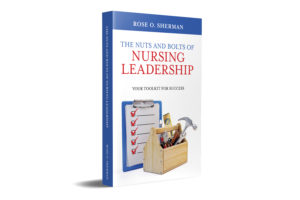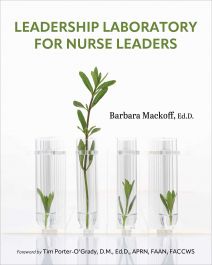By Rose O. Sherman, EdD, RN, NEA-BC, FAAN
The Leadership Laboratory for Nurse Leaders has been an AONL educational initiative for over a decade. Dr. Barbara Mackoff facilitates the program and just published a new book to help nurse leaders learn more about this approach to leadership development. Dr. Barbara Mackoff is a consulting psychologist, author, and educator. She is a Fulbright specialist and a senior faculty member at The American Organization of Nursing Leaders. She created and facilitates AONL’S national online Leadership Laboratory for Nurse Managers. Dr.Mackoff is the author of The Inner Work of Leaders and Nurse Manager Engagement and served on the faculty of nursing schools at Adelphi University and Molloy University and as a visiting scholar at Massachusetts General Hospital.
An Interview with the Author
- What inspired you to write this book?
Teaching and coaching nurse leaders have been the love of my professional life. One of my most spirited adventures has been creating a format– the leadership laboratory– as a way for nurses to capture and share instructive truths about their own experiences with each other. And then view these experiences through the lens of evidence-based leadership practice.
The book’s pages summarize ideas and examples from my work in teaching leader laboratories for over a decade. I also wanted to underline my belief in the resourceful power of peer wisdom. Every chapter is brimming with leaders’ stories and smart strategies. The book is my way of letting readers hear the voices and shiny ideas of so many of their colleagues.
I should add that after working with AONL fellowships, for the last 14 years, I wanted to donate all of my royalties to scholarship funds to enable nurse leaders to attend.
- Who is your target audience for the book?
My goal was to create a learning experience that could be used in three ways: as an individual self-guided exploration of leadership, as a workbook for academic leadership courses, and as a template for creating in-house leadership training. I hope aspiring and seasoned leaders will benefit from the research, reflective prompts, peer stories, and actionable strategies on the book’s pages.
- Reflection is a big part of your leadership laboratory program – what have you learned about reflection in leadership practice?
Reflection allows learners to capture their lived experiences and hold them up to a light that illuminates emotional insights and best practices. In the book, I use prompts, paintings, literature, quotes, peer examples, and expert counsel to elicit self-reflection.
In teaching in nursing schools and healthcare organizations, I learned that personal reflections and storytelling could bring research literature in nursing, psychology, and anthropology to life. Just as important: I have discovered that stories are sticky; stories beget stories. When we read –or listen to– peer leadership stories and reflections, we each recall our history and memories of learning to lead.
Yet leaders do not develop by reflection alone. I have learned to use reflection to bridge smart strategies and enhance leadership practice. Goethe’s call to action inspires me: “It is not enough to know; we must do.”
- You have developed eight leadership laboratories as part of your program – which one or two have you have to be most vital in leadership practice today?
I prize the paths to emotional mastery in each of the eight laboratories, but let me highlight two. I deliberately began the book with a laboratory about wise leadership–the capacity to learn from experience. The heart of leadership enrichment is making sense of your experiences and leveraging those insights to create growth and behavior change. In this laboratory, readers explore four keys to finding meaning in missteps and successes and carrying those lessons forward in new actions, attitudes, and commitments.
The laboratory on change agility is crucial in today’s practice environment. Nurse leaders are the change whisperers in their organizations. They are the ones who talk and walk their teams through change and crisis. They inspire and drive invocation and integrate new practices. At the same time, leaders must develop an inner coach because change also whispers to them. This lab explores change as both an emotional and a procedural issue.
5. If a CNO wants to set up a leadership laboratory using your work – how would you recommend getting started?
To open a dialogue with a CNO or education director who wants to create their in-house laboratory (without an outside consultant), I would explain that the keys are peer leadership and creating a comfortable climate to ensure open expression. I recommend 6-8 sessions– each corresponding to another chapter in the book. I suggest that an in-house educational specialist convene groups of 15-20 nurse managers or 15-20 directors from various clinical specialties. Every participant would have read and completed exercises in one chapter of the Leadership laboratory for Nurse Leaders for each session.
A different peer facilitator would lead each group meeting for 90 minutes and would lead discussions to explore responses to the topic and encourage the exploration of peer best practices.
You can purchase the Leadership Laboratory for Nurse Leaders at Amazon or any major book vendor. Dr. Mackoff can be reached at 206-384-6448 or blmackoff@gmail.com
© emergingrnleader.com 2022
Workshops are now also available onsite or hybrid.
Our Most Popular Right Now – Become the Boss No One Wants to Leave: Nurse Recruitment and Retention in Turbulent Times Retention WS Flyer
Give your leadership team the gift of a highly rated webinar – Nursing Leadership in 2022: Rebooting after a Life-Quake A Nursing Leadership Reboot Workshop
If you have a lot of new leaders, consider doing a Nuts and Bolts of Nursing Leadership Program – Nuts and Bolts Flyer Final
Read the Nurse Leader Coach – Available at Amazon and Other Book Sellers
Recommended Book by the Association of Critical Care Nurses – The Nuts and Bolts of Nursing Leadership: Your Toolkit for Success




 LinkedIn
LinkedIn Instagram
Instagram